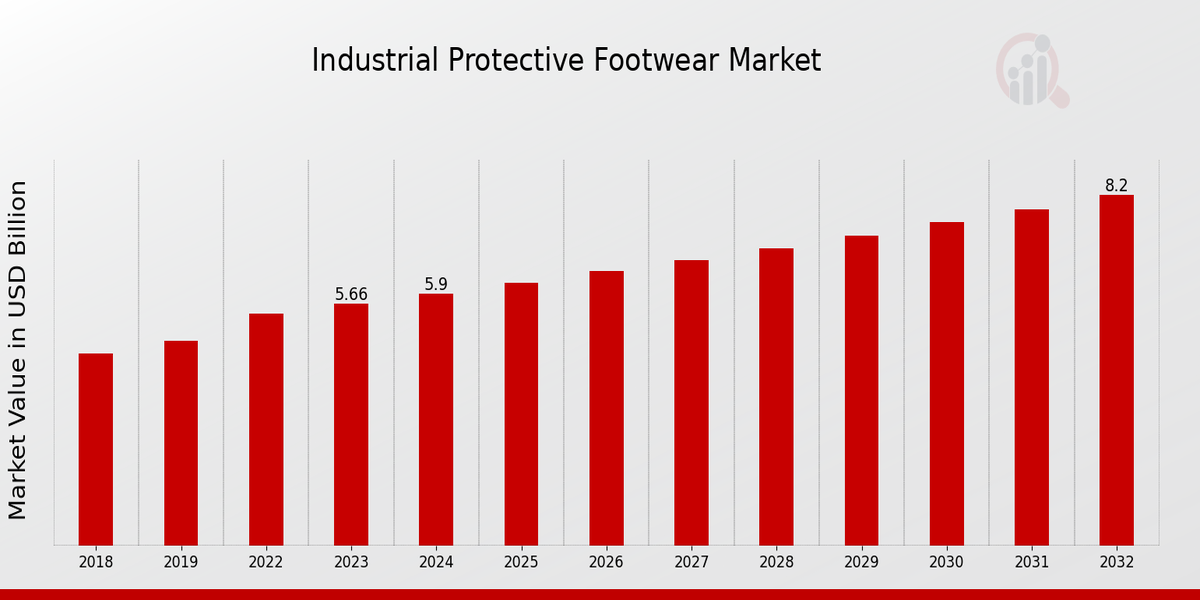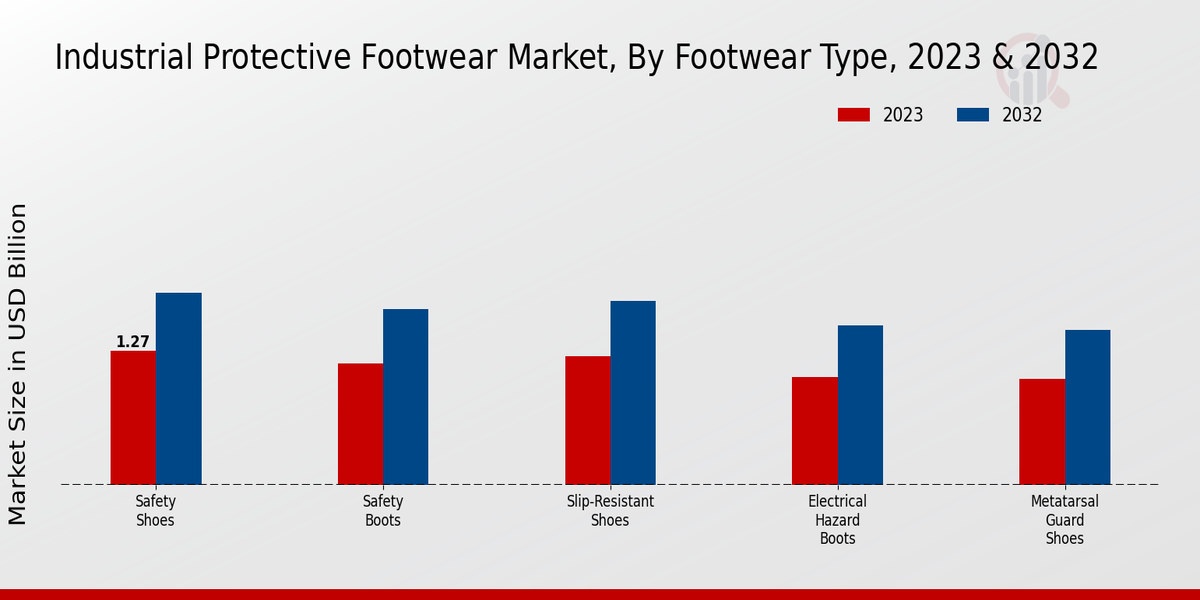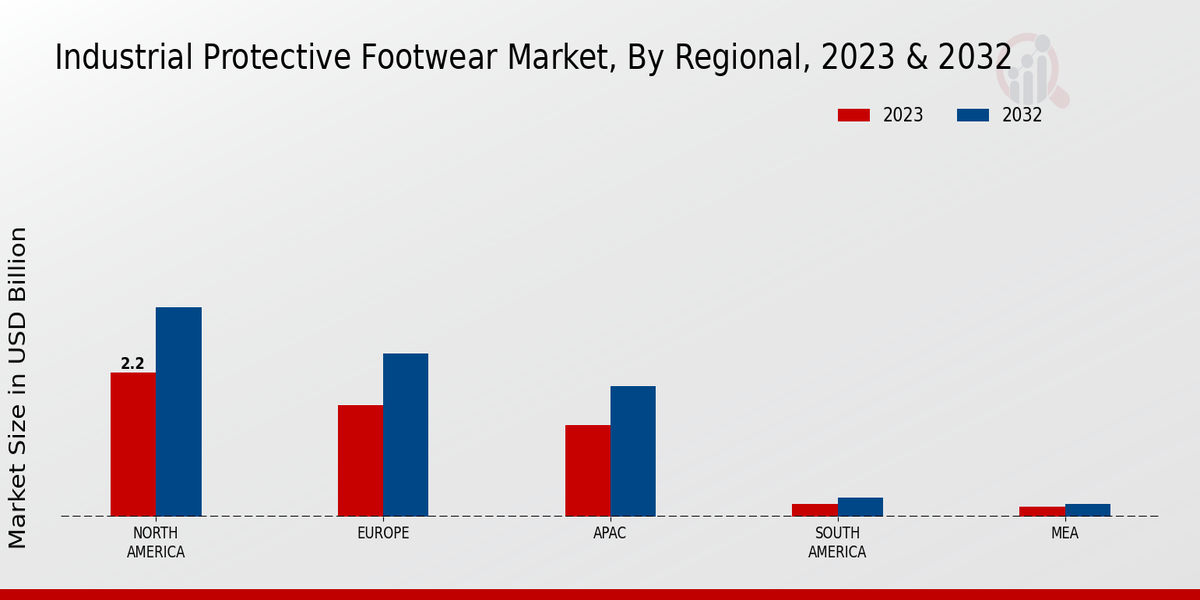Global Industrial Protective Footwear Market Overview
Industrial Protective Footwear Market Size was estimated at 5.43 (USD Billion) in 2022. The Industrial Protective Footwear Market Industry is expected to grow from 5.66(USD Billion) in 2023 to 8.2 (USD Billion) by 2032. The Industrial Protective Footwear Market CAGR (growth rate) is expected to be around 4.21% during the forecast period (2024 - 2032).
Key Industrial Protective Footwear Market Trends Highlighted
The Industrial Protective Footwear Market is experiencing significant growth driven by an increasing awareness of workplace safety. As industries evolve and regulations become more stringent, companies are investing in protective footwear to safeguard their employees from various hazards. The need for durable and reliable safety shoes that comply with safety standards is propelling the market forward. Additionally, the growing demand for specialty footwear for specific industries, such as construction, manufacturing, and healthcare, is boosting market development. Opportunities within the market include advancements in technology that allow for the creation of lighter, more comfortable, and more flexible footwear without compromising safety.Sustainable materials and practices are becoming more important as companies seek to improve their environmental footprint. The rise of e-commerce also opens new sales channels for manufacturers and retailers, allowing them to reach a broader audience. There is potential for innovation in designs that blend style with functionality, appealing to both safety-conscious consumers and those looking for fashionable options. In recent times, there has been a noticeable shift toward customization and personalization in protective footwear, catering to individual preferences and workplace requirements. The impact of global supply chain challenges has prompted manufacturers to explore local production options, enhancing flexibility and responsiveness to market demands.Emphasis on health and wellness, influenced by the recent pandemic, has further amplified the focus on comfort and ergonomics in protective footwear. Overall, the market is positioned for sustained growth as it adapts to evolving industry needs and consumer preferences.

Source: Primary Research, Secondary Research, MRFR Database and Analyst Review
Industrial Protective Footwear Market Drivers
Increased Awareness of Workplace Safety Regulations
The increasing emphasis on workplace safety regulations is one of the primary drivers contributing to the growth of the Industrial Protective Footwear Market Industry. As safety standards evolve and strengthen globally, organizations are compelled to adhere strictly to regulations that safeguard worker welfare. This has led to a heightened focus on equipping employees with protective gear suitable for their specific work environments. Protective footwear, which is a critical component of personal protective equipment (PPE), must meet these regulatory requirements to ensure safety from potential hazards such as slips, falls, and other workplace injuries.Moreover, industries that deal with hazardous materials, heavy machinery, and extreme environments are especially stringent about compliance, driving demand for robust and reliable protective footwear. The trend is further fueled by the potential financial implications of workplace accidents, including liability claims, insurance costs, and employee turnover. As a result, businesses are increasingly investing in high-quality industrial protective footwear to mitigate risks and foster a safer workplace culture.This growing sector directly correlates with the anticipated market value increase, where the market is projected to expand significantly by 2032. As awareness rises about both legal obligations and the moral imperative of protecting employees, the transition towards appropriate industrial protective footwear becomes critical. It's evident that employers are not only integrating protective footwear into their operational practices but are also striving to exceed basic compliance to promote a better safety culture.This proactive engagement is a substantial driving force for the Industrial Protective Footwear Market, creating a favorable environment for sustained growth.
Growth of the Construction and Manufacturing Industries
The robust growth of the construction and manufacturing industries significantly fuels the expansion of the Industrial Protective Footwear Market Industry. As these industries continue to flourish, the demand for protective footwear has surged, given the inherent occupational hazards present in such environments. Construction sites often involve heavy materials, sharp objects, and dangerous equipment, necessitating the use of proper safety gear to prevent injuries.This reality presents an ongoing opportunity for footwear manufacturers to innovate and produce specialized protective footwear designed to meet the unique challenges faced by workers in these sectors. The continuous investments in infrastructure development and industrial operations around the globe indicate a sustained upward trend, further amplifying the need for reliable industrial protective footwear. Therefore, as the construction and manufacturing industries evolve, they directly impact the demand dynamics within the market.
Technological Advancements in Footwear Design
Technological advancements in footwear design play a pivotal role in propelling the Industrial Protective Footwear Market Industry forward. Innovations such as the incorporation of lightweight materials, ergonomic designs, and enhanced protective features have transformed traditional approaches to protective footwear. Manufacturers are increasingly leveraging modern technology to create products that not only offer superior safety but also provide comfort and style.This shift enables employees to remain productive without compromising on protective measures. The consistent infusion of cutting-edge technologies, such as moisture-wicking properties, anti-slip soles, and resilience against extreme temperatures, caters to the evolving needs of diverse industrial environments, driving consumer preference toward advanced protective footwear solutions.
Industrial Protective Footwear Market Segment Insights
Industrial Protective Footwear Market Footwear Type Insights
The Industrial Protective Footwear Market exhibits significant diversity within its Footwear Type segment, which includes key categories such as Safety Shoes, Safety Boots, Slip-Resistant Shoes, Electrical Hazard Boots, and Metatarsal Guard Shoes. In 2023, Safety Shoes were valued at 1.27 USD Billion, highlighting their substantial role in workplace safety by providing essential protection against various hazards, which has driven their prominence in the market. Following closely, Safety Boots were valued at 1.15 USD Billion in the same year, known for their robust construction that is often essential in industrial sectors requiring enhanced ankle support and protection, making them a crucial component of the Industrial Protective Footwear Market segmentation.Slip-Resistant Shoes, valued at 1.22 USD Billion, play a significant role in industries where slips and falls are a high risk, thus facilitating safety protocols and compliance with safety standards. Electrical Hazard Boots, valued at 1.02 USD Billion, dominate environments with high electrical risks, providing protective features that are vital for workers operating in such conditions. Meanwhile, Metatarsal Guard Shoes, valued at 1.00 USD Billion, also hold importance due to their design, which protects the foot's metatarsals from crushing and impact hazards, thereby enhancing overall safety in the working environment.By 2032, all these categories are projected to grow, reflecting the increasing awareness of workplace safety and legislative requirements driving the demand for protective footwear. The market growth in these segments can be attributed to elevated safety regulations across various industries and the growing emphasis on employee safety and wellbeing, pushing industries toward investing in proper protective gear. Factors such as technological innovations in footwear design, incorporating lightweight materials and improved ergonomics further enhance the appeal of these products.Overall, the Industrial Protective Footwear Market data accentuates a strong demand for protective footwear types, which is likely to evolve alongside changing safety standards and workplace requirements.

Source: Primary Research, Secondary Research, MRFR Database and Analyst Review
Industrial Protective Footwear Market Material Insights
The Industrial Protective Footwear Market, valued at 5.66 USD Billion in 2023, showcases a diverse range of materials that cater to various safety requirements in industrial environments. Among these, leather and rubber are significant contributors, well-regarded for their durability and resistance to wear, aligning perfectly with the demands of heavy-duty workplaces. Polyurethane materials also play a crucial role, providing excellent cushioning and slip resistance, which enhances worker comfort and safety. Meanwhile, nylon is valued for its lightweight properties, offering versatility and breathability, essential in many industrial applications.Composite materials are becoming increasingly favored due to their lightweight nature and resistance to electrical hazards, making them essential for modern safety footwear solutions. The market growth is further driven by increasing industrial safety regulations and an emphasis on worker protection, while challenges such as fluctuating raw material prices may impact the overall Industrial Protective Footwear Market revenue. Continuous innovation in materials is expected to create new opportunities within the Industrial Protective Footwear Market industry.These evolving trends and advancements underline the importance of material selection in ensuring both safety and performance in protective footwear.
Industrial Protective Footwear Market End Use Industry Insights
The Industrial Protective Footwear Market is expected to reach a valuation of 5.66 USD Billion in 2023, highlighting the significance of safety in various End Use Industries. Each sector, including Construction, Manufacturing, Chemical, Oil and Gas, and Mining, plays a crucial role in driving market growth, given the inherent risks associated with these environments. Protective footwear is essential in construction due to the potential for heavy object impacts and slips, while the manufacturing sector emphasizes durability and comfort in high-traffic areas.The chemical industry demands specialized footwear resistant to hazardous substances, ensuring worker safety against exposure. In the Oil and Gas sector, footwear must provide protection against oil spills and extreme conditions, showcasing the need for advanced materials. Additionally, mining remains a dominant force due to its perilous working conditions, requiring robust protective footwear to safeguard workers’ health. The diversity within the Industrial Protective Footwear Market segmentation reflects unique needs, enabling growth opportunities and driving the overall demand for safety solutions across industries while being influenced by safety regulations and increased industrial activities.
Industrial Protective Footwear Market Risk Category Insights
The Industrial Protective Footwear Market, valued at 5.66 billion in 2023, showcases diverse risk categories that serve different safety needs across industries. The segmentation within the Risk Category encompasses Low Risk, Medium Risk, High Risk, and Extreme Risk footwear, addressing various safety hazards encountered in workplaces. Low-Risk footwear typically includes basic protective features ideal for environments with minimal hazards. Meanwhile, Medium Risk footwear is designed for moderate hazards, emphasizing enhanced protection and support.High-Risk options provide robust features for environments where injuries are more common, while Extreme Risk footwear is essential for high-stakes industrial applications, ensuring maximum safety against severe hazards. The Medium Risk and High-Risk categories are particularly important as they cater to a significant portion of the workforce, representing a majority holding in the market due to the growing need for compliance with safety regulations. Current market growth is driven by heightened awareness of workplace safety and increasing incidences of occupational injuries, compelling organizations to invest in reliable protective solutions.As the Industrial Protective Footwear Market data continues to evolve, understanding its segmentation remains crucial for addressing safety challenges effectively.
Industrial Protective Footwear Market Regional Insights
The Regional insights of the Industrial Protective Footwear Market reveal a diverse landscape. In 2023, North America leads the market with a valuation of 2.2 USD Billion, expected to grow to 3.2 USD Billion by 2032, showcasing significant market growth and dominance. Europe follows with a valuation of 1.7 USD Billion in 2023 and is projected to reach 2.5 USD Billion by 2032, highlighting its strong industrial base and safety regulations, which drive demand. The APAC region, valued at 1.4 USD Billion in 2023, is anticipated to grow to 2.0 USD Billion, benefiting from rapid industrialization and labor safety initiatives.South America and MEA are smaller players, with valuations of 0.2 USD Billion and 0.16 USD Billion, respectively, in 2023, indicating limited market activity but opportunities for growth driven by increasing awareness of workplace safety. Overall, the majority holding in the North American segment positions it as a critical player in the Industrial Protective Footwear Market industry, reflecting a vital focus on employee protection across various sectors.

Source: Primary Research, Secondary Research, MRFR Database and Analyst Review
Industrial Protective Footwear Market Key Players and Competitive Insights
The Industrial Protective Footwear Market is characterized by a diverse range of players and a substantial demand due to increasing safety regulations across various industries. The growing concern for employee safety has led to a significant focus on protective gear, including industrial footwear, which is designed to offer sufficient protection, comfort, and durability in demanding work environments. As companies expand their product portfolios and enter new geographical markets, the competitive landscape is continually evolving. Innovative materials, enhancement in design, and advanced manufacturing techniques are increasingly influencing consumer preferences, which in turn encourages manufacturers to adapt to changing market dynamics. The market's competitive insights reveal a blend of established companies and innovative startups aiming to carve out their share by addressing specific niche requirements and showcasing sustainability credentials.Bollé Safety stands out in the Industrial Protective Footwear Market thanks to its strong commitment to safety and innovation. The company has managed to position itself favorably among competitors by offering a comprehensive line of protective footwear solutions that cater to various industrial applications, including construction, manufacturing, and logistics. With an emphasis on research and development, Bollé Safety consistently introduces new product lines that incorporate the latest advancements in technology and materials, which enhances comfort levels while ensuring superior protection. Their products often feature advanced safety attributes such as slip resistance, composite toe caps, and water-resistant materials, contributing to their reputation as a reliable choice for employers focused on workplace safety. The brand's established presence in multiple regions and its strong distribution networks further bolster its competitive standing, allowing it to reach a wide consumer base effectively.Adidas' footprint in the Industrial Protective Footwear Market reflects its unique approach to blending athletic design with functional safety features. The company's entry into the industrial protective footwear space leverages its reputation for quality and innovation in the sporting goods sector, aiming to capture the attention of both businesses and consumers looking for footwear that offers both performance and protection. Adidas emphasizes sustainable practices, often utilizing recycled materials in their product lines, which aligns with growing environmental concerns among consumers and businesses alike. The emphasis on ergonomic designs ensures that the footwear not only meets safety standards but also enhances comfort during long hours of wear. Moreover, Adidas benefits from strong brand recognition and loyalty, allowing it to effectively market its protective footwear to various industries that prioritize both style and safety. The company’s strategic collaborations and marketing efforts further enhance its visibility and appeal within the competitive landscape of industrial protective footwear.
Key Companies in the Industrial Protective Footwear Market Include
- Bollé Safety
- Adidas
- Muck Boots
- Elten
- Honeywell
- Bata
- Dunlop Protective Footwear
- Carhartt
- Martens
- Caterpillar
- Shoe Zone
- Wolverine World Wide
- Lakeland Industries
- 3M
- Steel Blue
Industrial Protective Footwear Market Industry Developments
Recent developments in the Industrial Protective Footwear Market showcase an increased focus on safety regulations and innovations in product materials. Companies like Honeywell and 3M are driving advancements with technologies designed to enhance worker safety while also improving comfort. The rise in workplace accidents has led to a surge in demand for specialized footwear, prompting brands such as Caterpillar and Wolverine worldwide to expand their portfolios, offering products that blend both durability and style. Furthermore, partnerships and collaborations among these key players are becoming common as they seek to strengthen their market presence. Notably, Elten and Steel Blue are exploring sustainable materials in their footwear production, responding to the growing consumer demand for environmentally friendly products. The market is also witnessing competitive dynamics where companies like Adidas and Muck Boots emphasize sport-oriented designs for industrial applications. In terms of market value, growth has been significant, reflecting the increasing investments and consumer awareness regarding the importance of protective footwear across various industries.
Industrial Protective Footwear Market Segmentation Insights
Industrial Protective Footwear Market Footwear Type Outlook
-
- Safety Shoes
- Safety Boots
- Slip-Resistant Shoes
- Electrical Hazard Boots
- Metatarsal Guard Shoes
Industrial Protective Footwear Market Material Outlook
-
- Leather
- Rubber
- Polyurethane
- Nylon
- Composite
Industrial Protective Footwear Market End Use Industry Outlook
-
- Construction
- Manufacturing
- Chemical
- Oil and Gas
- Mining
Industrial Protective Footwear Market Risk Category Outlook
-
- Low Risk
- Medium Risk
- High Risk
- Extreme Risk
Industrial Protective Footwear Market Regional Outlook
-
- North America
- Europe
- South America
- Asia Pacific
- Middle East and Africa
| Report Attribute/Metric |
Details |
| Market Size 2022 |
5.43(USD Billion) |
| Market Size 2023 |
5.66(USD Billion) |
| Market Size 2032 |
8.2(USD Billion) |
| Compound Annual Growth Rate (CAGR) |
4.21% (2024 - 2032) |
| Report Coverage |
Revenue Forecast, Competitive Landscape, Growth Factors, and Trends |
| Base Year |
2023 |
| Market Forecast Period |
2024 - 2032 |
| Historical Data |
2019 - 2023 |
| Market Forecast Units |
USD Billion |
| Key Companies Profiled |
Bollé Safety, Adidas, Muck Boots, Elten, Honeywell, Bata, Dunlop Protective Footwear, Carhartt, Dr. Martens, Caterpillar, Shoe Zone, Wolverine World Wide, Lakeland Industries, 3M, Steel Blue |
| Segments Covered |
Footwear Type, Material, End Use Industry, Risk Category, Regional |
| Key Market Opportunities |
Rising manufacturing sector demand, Expansion in emerging markets, Increased workplace safety regulations, Adoption of smart footwear technology, Eco-friendly material innovations |
| Key Market Dynamics |
increasing workplace safety regulations, growing industrial activity demand, advancements in footwear technology, rising awareness of worker safety, expansion in emerging economies |
| Countries Covered |
North America, Europe, APAC, South America, MEA |
Frequently Asked Questions (FAQ) :
The Industrial Protective Footwear Market is expected to be valued at 8.2 USD Billion by 2032.
The projected CAGR for the Industrial Protective Footwear Market from 2024 to 2032 is 4.21%.
North America is anticipated to have the largest market share, valued at 3.2 USD Billion by 2032.
The market for Safety Shoes is expected to grow to 1.82 USD Billion by 2032.
The estimated market size for Safety Boots is expected to reach 1.66 USD Billion by 2032.
Major players in the market include companies such as Bollé Safety, Honeywell, and Caterpillar.
The expected market size for Slip-Resistant Shoes is projected to reach 1.74 USD Billion by 2032.
The market value attributed to Electrical Hazard Boots is estimated to be 1.51 USD Billion by 2032.
The market for Metatarsal Guard Shoes is expected to grow to 1.47 USD Billion by 2032.
The estimated market size for Europe is expected to reach 2.5 USD Billion by 2032.

















